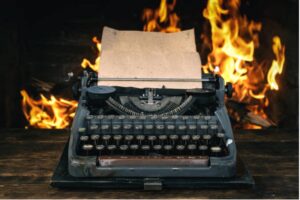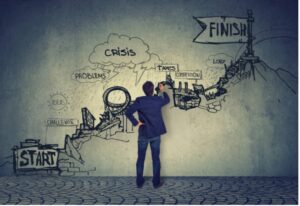
One of the first issues a writer tackles in a new story idea is determining where the conflict of the story lies, and what types of conflict they’re going to use.
Conflict is important in all good stories by creating an opposition against the protagonist. Without that opposition, the protagonist would achieve their goal rather quickly, and where is the fun in that?
As readers, we like to see our protagonist struggle.
We like to see them fight for what they want more than anything else, and then are rewarded or punished for it in the end. The answer of whether they achieve their goal keeps readers turning the page, and how well that conflict is crafted can determine how quickly those pages are turned.

Conflict Definition Literature
Conflict occurs when someone or something gets in the way of a character achieving their scene or story goal. It is used in stories to progress the story and to add interest.
Conflict can be internal, meaning it is caused by emotion, or external, meaning it is caused by something physical.
What Does Conflict Mean in a Story?
A protagonist can have two types of conflict.
- Internal, or;
- External conflict.
The most developed characters have both.
Types of Conflict: Internal vs External
This is where characters struggle with:
- Emotions,
- Morals,
- Ideals,
- Values, and;
- Desires,
which prevent them from achieving their goals.
This is where characters struggles against, or faces, an outside force that prevents them from achieving their goals.
The conflict in a story needs to create a significant opposition for the protagonist to overcome if the writer wants to create tension throughout the course of the work.
The difference between conflict and tension is often misunderstood.
Tension is the threat of danger, the anticipation of something bad happening to the character, whereas conflict is the active danger or bad thing keeping the character from meeting their goal.

7 Types of Conflict in a Story
Character vs Self
A character who battles their inner demons, fears, or anxieties can never fully move forward in the story until they have mastered whatever tortures them internally.
These stories reveal characters who ask big questions of themselves as Hamlet does in Shakespeare’s, Hamlet when he considers his own demise. “To be or not to be?” is a question that runs throughout the play and keeps Hamlet from moving toward his goal of discovering his father’s murderer.
Character vs Character
Characters who find their primary opposition with another character spend the duration of their story at battle with someone who can directly impact their goal.
In The Count of Monte Cristo, by Alexandre Dumas, Edmond Dantes spends the first part of the novel unaware that his best friend, Ferdinand Mondego has been conspiring against him out of a lifelong jealousy and desire to take his love.
Character vs Nature
For characters fighting against a natural environment, survival usually becomes a central goal.
Nature as opponent is not one that can be countered with logic.
Santiago, in Ernest Hemingway’s The Old Man and the Sea is a classic example of a single protagonist in conflict with a force greater than himself in the natural environment.
Character vs Fate
Characters fighting against fate, or a godlike figure is one of the oldest conflicts in storytelling.
In the epic of Beowulf, Beowulf fights against monsters, but it is his fated journey that carries him to his final moments as king. Much like the epic of Beowulf, the epics of the Greek and Roman classics also reveal conflicts of fate for many of those heroes.

Character vs Society
Characters fighting against society are also fighting against an ideology.
Consider the way Winston Smith fights against Big Brother in Orwell’s, 1984. Winston believes true freedom exists in the ability to say 2+2=4, a truth The Party of Big Brother denies with the edict that 2+2=5.
The Party is a society that seeks to control the individual, and Winston is willing to risk his life for a few cubic centimeters of individual brain space.
Character vs Technology
Characters fighting technology are also fighting against a progressive scientific thought.
Usually, these stories introduce a moral dilemma with the scientific advancements the protagonist battles.
Kazuo Ishiguro is a master at introducing these big moral questions, as he does in his novel, Never Let Me Go. The question of what makes us human and where science should advance is a difficult one for the protagonist and narrator, Kathy.
Character vs the Supernatural
Characters who battle the supernatural are up against otherworldly forces.
For the mariner in Samuel Taylor Coleridge’s, The Rime of the Ancient Mariner, the battle against the supernatural force that punishes his choice to kill the albatross creates great conflict as well as great lessons for honoring the natural in this infamous poem.
How to Write Types of Conflict
For writers, creating conflict must begin with understanding a character’s central goal.
A character goal must show high stakes in the story, meaning this goal must be the most important want for the protagonist. If this character is not willing to risk everything to achieve this goal, the stakes are weakened, and the story loses the tension that creates forward movement in the plot.
Once a writer determines this goal, and is clear about the stakes of the goal, they can begin to create different types of conflict by opposing the different goals in one of the aforementioned ways.
The challenge exists in creating a balance in the story.
If the types of conflict your write always result in the the protagonist is failing, a reader might become exhausted by the consistent loss and close the book.
If the types of conflict you write are so small the protagonist is always winning, the story will lack tension and the reader will feel little urgency in turning the pages, another reason to put the book down too soon.
For writers who want to strike that balance of great tension, the opposing force must be equal to the character goal.
For more information on how external conflict links to point of view character goals, read https://fictionary.co/journal/how-external-conflict-links-to-pov-character-goals/
Conclusion
Writers who can master the balance of conflict in a story captivate their readers.
Readers want to feel they have succeeded with their characters. And since readers exist in the head of a protagonist for the duration of the story, every win for the protagonist is a win for the reader.



